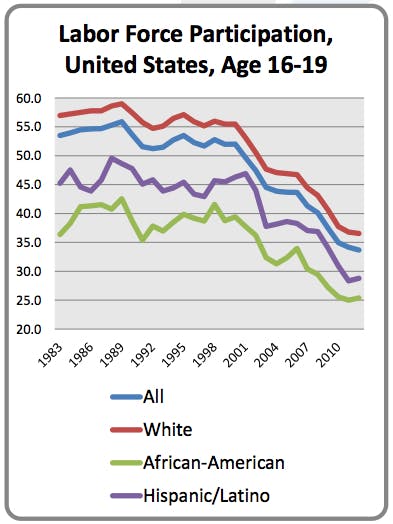In 1989, 56 percent of the 16- to 19-year-olds in America were actively participating in the workforce.
This meant that an employer hiring a young person in the late 1980s and early 1990s had better than a one-in-two chance that the young person they were considering understood what it meant to hold a job.
In 2012, however, only 33 percent of those in the same age group are actively participating in the workforce. And the numbers for African-American and Hispanic teens are much lower.
Since 1989, a steady decline in teen employment
That means today’s employers are forced to roll the dice in hopes of landing that one-in-three among job applicants who has any clue of what it takes to get and keep a job. The remaining 66 percent won’t truly realize that having a job requires them to arrive on time, dressed appropriately, that they must take direction, and that they must be ready to work hard to create value for their employer regardless of the tasks they are assigned.
These findings are a part of a stunning white paper report (titled Shrinking Teen Labor Force Participation) compiled by Patrick J. Holwell, a workforce economist for the Arapahoe-Douglas Workforce Center in Denver, Colorado.
Holwell’s research shows a steady decline in teen employment since 1989, proving that this downward trend (and today’s dismal participation by teens in the workforce) can’t be blamed on the most recent recession. While many teens aren’t working because they can’t find employment, many others simply don’t want to work or their parents are over-scheduling them with school and extra-curricular activities, making a job difficult or impossible.
Sadly, the majority of the next age cohort is woefully unprepared to join the labor force and the current — and future — waste of economic potential is staggering, to say the least. Across all industries, business operations are likely to suffer when hiring and training costs increase; and how could they not escalate exponentially?
Suggestions for employers
There are solutions to reverse this trend. Holwell provides several suggestions for concerned employers:
1. Work to ensure teens have more paid or unpaid employment opportunities, particularly over the summer.
- Subsidized summer employment coupled with academic remediation for lower skilled teens.
- Partner with area businesses in key regional industry sectors to provide paid or unpaid internships for local teens throughout the year.
- Boost efforts to connect employers willing to hire inexperienced teens with teens wanting work
2. Find ways throughout the year to provide formal training for teens in the skills necessary to find and keep a job, and advance their careers. John F. Kennedy once said, “A rising tide lifts all boats.” Employers who don’t hire teens should realize that their future workforce are teens now, and that my stretching to provide opportunities for youth now will pay huge dividends for their particular employment boat in a few short years.
SHAMELESS PROMOTION: I’m proud that Holwell’s agency, ADWorks, was the first workforce center in the country to pilot my Bring Your A Game to Work program for youth. Over the past three years, ADWorks has put more than 500 teens and twenty-somethings through this work ethic training and certification program, and 98 percent of the employers who’ve hired them have reported a high level of satisfaction with these young workers. That’s a remarkable improvement from the 50 percent percent satisfaction rating among those same employers that have hired youth who’ve not been through the training.
This was originally published on Eric Chester’s Reviving Work Ethic blog. His new book is Reviving Work Ethic: A Leader’s Guide to Ending Entitlement and Restoring Pride in the Emerging Workforce. For copies, visit revivingworkethic.com.
